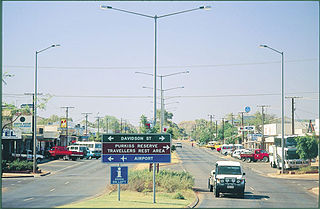
The Northern Territory is an Australian territory in the central and central northern regions of Australia. The Northern Territory shares its borders with Western Australia to the west, South Australia to the south, and Queensland to the east. To the north, the territory looks out to the Timor Sea, the Arafura Sea and the Gulf of Carpentaria, including Western New Guinea and other islands of the Indonesian archipelago.

The Adelaide–Darwin railway line is a railway line in Australia, between the South Australian town of Tarcoola and the Northern Territory city of Darwin. Preceded by a number of other shorter railways, a line through to Darwin was fully realised in 2004 when the final link from Alice Springs to Darwin was opened. Forming the main section of the 2,975 kilometres (1,849 mi) rail corridor between the cities of Adelaide and Darwin, the line is used by The Ghan passenger train and interstate freight trains operated by Aurizon.

Tennant Creek is a town located in the Northern Territory of Australia. It is the seventh largest town in the Northern Territory, and is located on the Stuart Highway, just south of the intersection with the western terminus of the Barkly Highway. At the 2021 census, Tennant Creek had a population of 3,080 people, of which 55% (1,707) identified themselves as Indigenous.

The NORFORCE is an infantry regiment of the Australian Army Reserve. Formed in 1981, the regiment is one of three Regional Force Surveillance Units (RFSUs) employed in surveillance and reconnaissance of the remote areas of Northern Australia. It consists of a regimental headquarters, four surveillance squadrons, and an operational support squadron and training squadron.

Pine Creek is a small town in the Katherine region of the Northern Territory, Australia. As at the 2021 Census there were 318 residents of Pine Creek, which is the fourth largest town between Darwin and Alice Springs.
Tennant Creek Airport is a small regional airport located near Tennant Creek, Northern Territory, Australia.

The McArthur River mine is a zinc-lead mine, situated about 70 kilometres southwest of Borroloola, near the Gulf of Carpentaria in the northeastern Northern Territory, Australia. It is operated by McArthur River Mining (MRM), a subsidiary of the Swiss mining company Glencore. Although discovered in the 1950s, when it was originally called the HYC or "Here's Your Chance" deposit, it only opened as a mine in 1995. Initially an underground mining operation, the mine has been converted to open-cut.

Lake Mary Ann or Tingkkarli, previously known as Mary Ann Dam is situated about 5 kilometres (3.1 mi) north of Tennant Creek, Northern Territory, Australia, just off the Stuart Highway. It is a man-made dam where some water sports can be conducted such as swimming or canoeing, surrounded by landscaped grassy areas on one side and natural bushland on the other.
Southport is an outer rural locality in Darwin. It is based on the site of the abandoned Town of Southport, a thriving river port during the Pine Creek gold rush of the 1870s. It is located at the junction of the Blackmore and Darwin Rivers.
Rugby league in the Northern Territory is administered by the Northern Territory Rugby League and is played in Darwin at Warren Park and in Alice Springs at Anzac Oval.
The Warumungu are a group of Aboriginal Australians of the Northern Territory. Today, Warumungu are mainly concentrated in the region of Tennant Creek and Alice Springs.

The Tennant Creek Telegraph Station is an historical site about 16 kilometres north of Tennant Creek in the Northern Territory of Australia.

The Church of Christ the King is located in Tennant Creek in the Northern Territory of Australia. The church was relocated from the historic mining town of Pine Creek. With parts of the church spread between the two towns during the move, it was once known as the "longest church in Australia".

Nobles Nob mine is a gold mine in the Northern Territory of Australia located in the locality of Warumunga about 13 kilometres (8.1 mi) south-east of the town of Tennant Creek. It was once the richest gold mine for its size in the world.

William Henry Charles Fullwood, better known as Bill Fullwood is one of the most significant artists from the Barkly region of the Northern Territory of Australia, best known for his depictions of scenes of the Barkly region. He was a long-term resident and mining pioneer of Tennant Creek. The historic Tuxworth Fullwood House is named after him.

North Limited was a diversified mining and resources company. Although based in Australia, its operations eventually extended to six continents. By the late 20th century the company had become the fourth largest iron ore exporter in the world with expansion underway which would have made it equal third. Its biggest asset was a majority stake in Robe River, a major miner of the Pilbara iron ore deposits of Western Australia and the world's lowest cost producer of iron ore.
This is a list of members of the Northern Territory Legislative Council from 10 December 1949 to 28 April 1951.

The Amadeus Gas Pipeline is a bi-directional natural gas pipeline running north–south through the Northern Territory of Australia. Its southern extent is the Amadeus Basin gas fields west of Alice Springs. The Amadeus pipeline is owned and operated by APA Group, and regulated by the Australian Energy Regulator.
Ti-Tree Airfield (ICAO:YTIT), also known as Ti Tree aeroplane landing area (ALA) is a landing strip in the Northern Territory of Australia located in the town of Ti-Tree.














